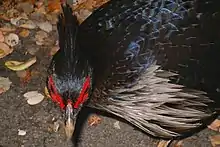Kalij pheasant
The kalij pheasant (Lophura leucomelanos) is a pheasant found in forests and thickets, especially in the Himalayan foothills, from Pakistan to western Thailand. Males are rather variable depending on the subspecies involved, but all have an at least partially glossy bluish-black plumage, while females are overall brownish. Both sexes have a bare red face and greyish legs (the latter separating it from the red-legged silver pheasant).[2] It is generally common and widespread, though three of its eastern subspecies (L. l. oatesi, L. l. lineata, and L. l. crawfurdi) are considered threatened and L. l. moffitti is virtually unknown in the wild.[2]
| Kalij pheasant | |
|---|---|
 | |
| Male L. leucomelanos hamiltoni, Uttarakhand, India | |
 | |
| Female L. leucomelanos hamiltoni, Uttarakhand, India | |
| Scientific classification | |
| Kingdom: | Animalia |
| Phylum: | Chordata |
| Class: | Aves |
| Order: | Galliformes |
| Family: | Phasianidae |
| Genus: | Lophura |
| Species: | L. leucomelanos |
| Binomial name | |
| Lophura leucomelanos (Latham, 1790) | |
The name is also spelled kaleege in old texts, such as Game Birds of India and Asia by Frank Finn,[3] though no longer in his Indian Sporting Birds.[4] The species was introduced to Hawaii[1] in 1962 as a gamebird.[5]
Taxonomy
The kalij pheasant is closely related to the silver pheasant, and the two are known to hybridize.[6] The placement of the taxa L. l. lineata and L. l. crawfurdi has been a matter of dispute, with some treating them as subspecies of the kalij pheasant[2] and others as subspecies of the silver pheasant.[7] They have greyish legs as in the kalij pheasant, but their plumage is closer to that of some subspecies of the silver pheasant. Additionally, as the silver pheasant, L. l. lineata and L. l. crawfurdi are found east of the Irrawaddy River, a major zoogeographic barrier, while all other subspecies of the kalij pheasant are found west of the river (L. l. oatesi, a subspecies of the kalij pheasant, has sometimes been reported as occurring east of that river,[2] but this is incorrect[8]). Based on mtDNA, it was recently confirmed that L. l. lineata and L. l. crawfurdi should be regarded as subspecies of the kalij pheasant.[9]
Subspecies
The nine recognized subspecies of the kalij pheasant are, in taxonomic order:
- L. l. hamiltoni J.E. Gray, 1829) – white-crested kalij pheasant – western Himalayas
- L. l. leucomelanos (Latham, 1790) – nominate – forests of Nepal
- L. l. melanota (Hutton, 1848) – black-backed kalij pheasant – Sikkim and western Bhutan
- L. l. moffitti (Hachisuka, 1938) – black kalij pheasant – central Myanmar
- L. l. lathami (J.E. Gray, 1829) – Horsfield's pheasant – eastern Bhutan and northern India to Myanmar
- L. l. williamsi (Oates, 1898) – Williams' kalij pheasant – western Myanmar
- L. l. oatesi (Ogilvie-Grant, 1893) – Oates' kalij pheasant – southern Myanmar
- L. l. crawfurdi (J.E. Gray, 1829) – Crawfurd's pheasant – southeastern Myanmar to peninsular Thailand
- L. l. lineata (Vigors, 1831) – lineated pheasant – southern Myanmar to northwestern Thailand
Description

Males have a total length of 63 to 74 cm (25 to 29 in) and females 50 to 60 cm (20 to 24 in).[2] Height is... Very roughly, the subspecies can be divided into two main groups, with the first (subspecies L. l. hamiltoni, L. l. leucomelanos, L. l. melanota, L. l. moffitti, and Vlathami) being found in the western and central part of the species' range, while the second (L. l. williamsi, L. l. oatesi, L. l. lineata, and L. l. crawfurdi) is found in the eastern part. In the males of the first group, most of plumage is glossy blue-black, though with white to the rump or underparts in most subspecies, and in L. l. hamiltoni, the westernmost subspecies, the crest is white (all other have a blue-black crest). In the second group, the underparts and crest are glossy blue-black, but the tail and upperparts are white (or very pale grey) with most feathers densely vermiculated with black.[2]
Females are brownish. In some subspecies, the underparts are distinctly marked in whitish and black, while in others, most feathers are pale-edged, resulting in a scaly appearance.[2]
References
- BirdLife International (2013). "Lophura leucomelanos". IUCN Red List of Threatened Species. 2013. Retrieved 26 November 2013.CS1 maint: ref=harv (link)
- McGowan, P. J. K. (1994). Kalij Pheasant (Lophura leucomelanos). pp. 533 in: del Hoyo, J, A. Elliott, & J. Sargatal (1994). Handbook of the Birds of the World. Vol. 2. New World Vultures to Guineafowl. Lynx Edictions. ISBN 84-87334-15-6
- Finn, F. (1911?). Game Birds of India and Asia.
- Finn, F. (1915). Indian Sporting Birds.
- "Lophura leucomelanos | Kalij pheasant". hawaiibirdingtrails.hawaii.gov. State of Hawaii. Retrieved February 25, 2018.
- MacKinnon, J., & K. Phillipps (2000). A Field Guide to the Birds of China. Oxford University Press. ISBN 0-19-854940-7
- McGowan, P. J. K., A. L. Panchen (1994). Plumage variation and geographical distribution in the Kalij and Silver Pheasants. Bulletin of the British Ornithologists' Club. 114: 113-123.
- Robson, C. (2000). A Field Guide to the Birds of South-East Asia. New Holland Publishers. ISBN 1-85368-313-2
- Moulin, S., E. Randi, C. Tabarroni, & A. Hennache (2003). Mitochondrial DNA diversification among the subspecies of the Silver and Kalij Pheasants, Lophura nycthemera and L. leucomelanos, Phasianidae. Ibis 145: E1-E11
External links
| Wikispecies has information related to Lophura leucomelanos. |
![]() Media related to Lophura leucomelanos at Wikimedia Commons
Media related to Lophura leucomelanos at Wikimedia Commons
